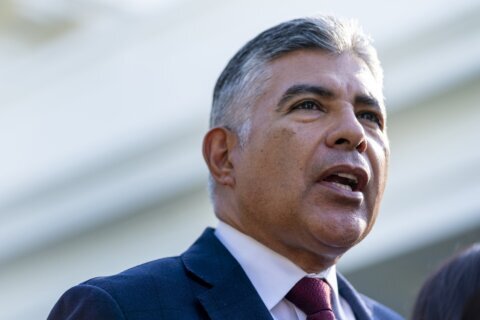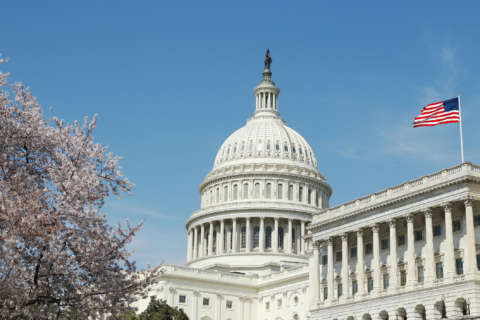With a budget deadline fast approaching Sunday, Oct. 1, and the two chambers of Congress starkly divided, a government shutdown seems imminent.
The 2018-2019 shutdown, that lasted a record 35 days, is still fresh in the minds of D.C. area residents. Many federal and contract workers around the District are wondering if they should be preparing to be furloughed or work without pay for an indefinite amount of time.
Americans that don’t work for the government will also be affected, as government and federally funded services will be restricted or delayed.
Let’s jump into what exactly is fueling this possible shutdown and how it could affect you.
- Q: Why is this happening? Is there still the possibility that a full shutdown could be avoided?
Each year the House and Senate have to pass 12 federal spending bills that fund different agencies across the federal government. This process can take weeks or even months.
The two chambers have struggled to agree on and pass any spending bills this year for the next fiscal year, as hard-right representatives in the Republican-controlled House are calling for budget cuts across many agencies and the slim majority of Democrats in the Senate want to maintain current funding levels.
Both chambers are struggling to pass stopgap bills that would temporarily extend federal funding for a few months, to avoid a government shutdown that is approaching when the new fiscal year starts on Saturday night.
More Government Shutdown 2023 News
- How would a government shutdown affect SNAP, student loans and travel?
- Which state would be hurt most by government shutdown?
- Why government contractors could be some of the hardest hit during a shutdown
- Where federal workers can get deals on food, drinks (if the government shuts down)
- How to get unemployment insurance as a furloughed federal worker
With such different priorities dividing Congress, it doesn’t look like a full shutdown can be avoided.
- Q: If there's a shutdown, would federal workers be sent home?
If federal funding stops, hundreds of thousands of federal workers are expected to be furloughed, according to the Federal News Network.
Sholanda Young, the director of the Office of Management and Budget, said during a press conference Friday that about 700,000 federal employees would be furloughed, meaning they would stay home and not work during the shutdown.
Furloughed employees will not work during the shutdown, but will be paid backpay once it is over. During past shutdowns, that has led to the shutdown or slow down of agencies where the majority of workers being furloughed.
The IRS has already announced that they will be partially closing again this year if there is a shutdown. The National Parks Service will also be furloughing about 13,000 of their 19,000 workers and closing the majority of national parks.
Many service employees, including cleaners, cafeteria workers and security officers that work in federal buildings will also be working without pay during a shutdown and getting back paid later.
Federal workers that are excepted or furloughed have struggled financially during past shutdowns and are bracing for losing their paychecks for another indeterminate amount of time.
- Q: How many federal employees would keep working?
According to an analysis by Federal News Network, more than 1.5 million civilian federal workers — about 65% of the federal civilian workforce — would be either “exempt” or “excepted” from shutdown furloughs.
Young said during a Sept. 29 press conference that “about 800,000 people would be excepted across the government,” which means that their work will continue but they will not be paid until the shutdown is over.
That includes workers in the Department of Defense, Department of Homeland Security, Department of Justice, Social Security Administration, Department of Transportation and in many other agencies.
Notably, congressmembers, the President, Supreme Court justices and appointed judges will continue to be paid during the shutdown but most of their staff will be excepted and work without pay during the duration of the shutdown.
For the breakdown on how many workers in each federal department should be excepted or exempted, check out the Federal News Network’s full analysis.
- Q: How does this affect the DC region? How will Maryland and Virginia be affected?
The Metropolitan Washington Council of Governments also said in a statement that nearly 400,000 residents in the D.C. area work for the federal government, making it the region’s largest employer.
About 22% of the District’s workforce are full-time federal civilian employees, according to their release. Federal employees also made up a little over 16% of the workforce in the Maryland suburbs and northern Virginia in their analysis.
DC court system
Although the D.C. courts are federally funded, most divisions will continue to operate and provide services, with the majority of employees working and accumulating backpay during a prospective shutdown.
The only service that will not be offered by the courts during a shutdown is issuing marriage licenses and performing marriage ceremonies, according to the agency’s shutdown plan.
Virginia and Maryland
U.S. Sen. Mark Warner, D-Va., said that the Commonwealth has more than 170,000 federal employees and tens of thousands of military personnel stationed at bases across the state, as well as at the Pentagon. He added that many federal contractors, that may lose work during the shutdown without the promise of backpay, live in Virginia.
Warner and Sen. Tim Kaine, D-Va., said in a joint statement that 129,400 active-duty service members in Virginia will be working without pay during a potential shutdown, which would impact their families.
Similarly, nearly 30,000 active duty troops in Maryland would be forced to work without pay, according to Sen. Chris Van Hollen, D-Md.
He added that with many families with federal jobs struggling to pay bills during the shutdown, there could be a real strain on local services that also rely on federal funding, like Meals on Wheels services.
Rep. Jennifer Wexton, D-Va., also said in a statement that “the Department of Agriculture would be forced to stop processing housing loans, which provide $646,724,633 in funding to help 3,311 families in rural Virginia communities buy homes every year.”
The White House also determined that medical trials at the National Institutes of Health in Bethesda, Maryland, would be among those ceasing if a shutdown does happen.
- Q: What happens to the Smithsonian museums and National Zoo? What about the National Mall?
Depending on how long the shutdown stretches on, it could affect the National Zoo and the Smithsonian museums.
For now, the Smithsonian Institution says it will use prior-year funds to remain open to the public in the event of a shutdown. All museums and the National Zoo will remain open until till at least Saturday, Oct. 7, the Smithsonian said.
The Smithsonian Institute will continue to keep the public updated with a statement next week.
During the last shutdown, the Smithsonian museums initially stayed open before, eventually, having to close their doors as the funding lapse continued.
The U.S. Department of the Interior said in a statement that parks in areas where it is impossible or impractical to restrict access to the public, including the National Mall and Memorial Parks in Washington, D.C., will remain open to the public.
However, most park staff will be furloughed so services including restroom maintenance, trash collection, road maintenance, campground operations and emergency operations will not be guaranteed.
- Q: If there is a government shutdown, how would it impact government contractors and their employees?
David Berteau, president of the Professional Services Council, a trade association for government contractors, said that while federal workers may not feel the impact of a shutdown until they get their first paycheck, for contractors and their workers, it could be felt immediately.
He said many contractors are required to keep working unless something gets in the way of them doing their work, and they are told to stop.
“If a stop work order is issued, then you no longer can pay that person unless you’re willing to pay them out of other funds that will run out because you’re not getting reimbursed by the government,” Berteau said.
He said seeing a stop work order is common, because many contractors depend on things such as access to federal properties and interactions with feds to do their work.
“You may have something you have to deliver to the government — a software program, a package, an airplane — and there’s nobody to sign off on accepting the delivery.” Additionally, a stop work order could be given if a contractor runs out of money for a project.
Berteau said when a shutdown happens, some contractors may still be waiting for the government to pay an invoice because it takes around 30 days for that to happen. Thus, a shutdown could lead to a backlog of those payments.
Also, a lack of staff could lead to invoices not being approved or no money being available to pay contractors for their work.
After previous shutdowns, including the partial shutdown in 2018 that lasted more than 30 days, many contractors have better plans to react to a shutdown. Such plans include communicating with government liaisons about what will happen and communicating with employees about what to expect.
“Internal communications is really critical and important,” Berteau said.
Recent legislation guarantees feds will receive backpay after a shutdown, but the same isn’t true for contracted employees.
“There’s never been a designated backpay for contractors, even though they were affected and driven into that situation by the same dynamics as the government civilian employees,” he said.
Berteau said another concern for contractors is if the budget can will be kicked down the road with a one or two-week continuing resolution.
“Very little happens in the contract world in that case, other than potentially, maybe, paying invoices, but only if you’re at the very top of the list,” Berteau said.
- Q: What local resources are available for federal employees impacted by the shutdown?
There are roughly 400,000 federal government employees in the D.C. region, many of whom will go without a paycheck if the federal government shuts down. Even with back pay likely when the shutdown ends, that could mean weeks of financial hardship.
Many of those employees also bank with credit unions tailored to them, and several have announced furlough relief programs to help them get by. Check out what programs Navy Federal Credit Union, PenFed Credit Union, Congressional Federal Credit Union and USAA are offering here.
Another option is that government workers and contractors can start filing for unemployment insurance.
Most employees, even if they live in Virginia or Maryland, will file for unemployment in D.C.
In D.C., the maximum weekly benefit is $444 and if the government is shut down and you are furloughed, you will be able to apply for benefits on Sunday, Oct. 1. Workers will then be required to pay back the unemployment wages when they receive backpay when the shutdown ends.
“There are eligibility requirements that you have to meet,” Unique Morris-Hughes, director of the D.C. Department of Employment Services, told WTOP. “My recommendation is to read through them very clearly and then make an informed decision if you’d like to apply for unemployment insurance benefits.”
You can check those requirements on the Employment Services website.
Outside of unemployment, there is also an array of state programs in Maryland, covering food assistance, energy bills, healthcare resources and more, that have been highlighted by Prince George’s County Executive Angela Alsobrooks on her website.
- Q: Which government benefits and programs would be affected? How long till they stop going into effect?
Programs that rely on appropriated funds — that Congress needs to approve every year — are the ones most in jeopardy during a government shutdown.
That means Social Security, Medicare and Medicaid are safe.
SNAP benefits and other government programs reliant on appropriations could be affected. During past shutdowns, states were given funding ahead of time for those programs.
However, those benefits will likely only be covered for about 30 days after a shutdown, according to Joseph Cordes, a professor of economics and public policy at the George Washington University in D.C.
Young also outlined what will happen to those programs during a White House press conference.
“Long term disaster recovery would be further delayed,” she said. “Nutrition Assistance for nearly 7 million women and children who rely on WIC would be jeopardized. Small businesses would lose out on more than $100 million a day in loans.”
That’s because the federal contingency fund supporting normal WIC operations and other similar programs will likely run out in a matter of days — pushing states to rely on their own money or carry-over funds.
Many agencies and programs that rely on federal grant money will also take a funding hit, such as the Head Start program that supports disadvantaged children.
Young also touched on the Federal Emergency Management Agency’s operations and how the agency is holding funding on many rebuilding projects while preparing for any large catastrophic events that they may need to us their limited leftover funding on.
“FEMA is holding over 2,000 projects in advance, because of their current fiscal situation. When did we tell Congress about this, in mid August, it is now late September,” Young said. “And they are now marching us towards a shutdown where those 2,000 projects just get held longer, and longer and longer.”
With many workers furloughed at the Education Department, students applying for federal aid during a shutdown can expect delays. Officials have pointed to potential disruptions to processing FAFSA applications, disbursing Pell Grants and pursuing public loan forgiveness, for example.
Student loan payments, which will start again on the same day of the possible shutdown, will still continue.
The Associated Press and WTOP’s Kyle Cooper, Mike Murillo and Mitchell Miller contributed to this report.








